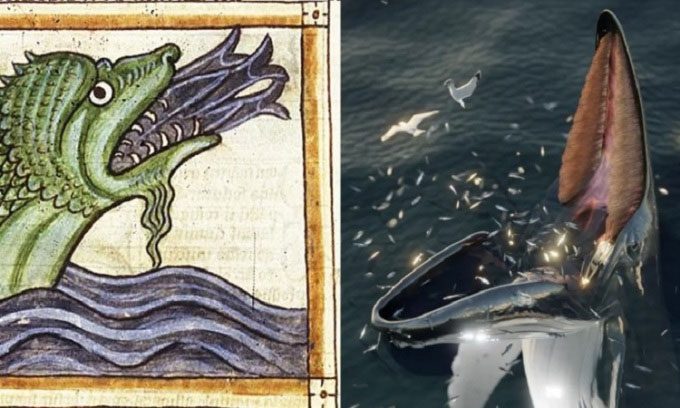There is some evidence suggesting that the descriptions of sea monsters in 13th-century Nordic manuscripts might actually be referring to whales that employ a hunting strategy known as trap feeding, rather than merely being mythical tales.
A sea monster mentioned in a 13th-century Nordic manuscript is likely to be whales utilizing a hunting technique called trap feeding. Scientists only described this feeding behavior about a decade ago after observing humpback whales (Megaptera novaeangliae) and Bryde’s whales (Balaenoptera brydei) waiting for prey in a vertical, motionless position at the water’s surface with their mouths wide open. Shoals of fish might mistake the whale’s mouth for a safe haven and swim directly into this deadly trap.

Illustration of a sea monster in medieval manuscripts (left) and a whale waiting for prey to jump in (right). (Photo: J. McCarthy).
“I read some Norse mythology and noticed that the monsters described bear a striking resemblance to the well-known feeding behavior of whales,” shared John McCarthy, a maritime archaeologist at the School of Humanities, Arts, and Social Sciences at Flinders University in Australia. “Upon further investigation, we discovered the similarities to be truly astonishing.”
Marine biologists, archaeologists, linguists, and medieval literature experts collaborated to explore the parallels between the behavior of the monster referred to as “hafgufa” in ancient Nordic manuscripts and the feeding strategies of whales. They published their findings on February 28 in the journal Marine Mammal Science.
Detailed descriptions of hafgufa, which means “sea mist” in English, appear in the 13th-century manuscript “Konungs skuggsjá” written for King Hákon Hákonarson of Norway, who reigned from 1217 to 1263. However, the research team uncovered multiple references to hafgufa in a text titled “Physiologus” from the 2nd century, which includes illustrations of a whale-like creature with other fish jumping into its mouth.
According to the researchers, medieval sailors may have understood hafgufa to be a type of whale rather than a mythical monster. The Norse were veteran sailors, and most of their voyages during the Middle Ages in Scandinavia were aimed at fishing. Thus, they possessed extensive knowledge of tides, ocean currents, wave patterns, and fish species, as noted by Lauren Poyer, an assistant professor in the Scandinavian Studies Department at the University of Washington.
In the ancient Nordic manuscript, the hafgufa emits a scent that attracts fish to jump into its mouth. The new study suggests that this peculiar scent might be similar to a “rotten cabbage” smell associated with the feeding behavior of whales. Humpback whales and Bryde’s whales also produce distinctive odors when they regurgitate food to attract more prey to swim into their motionless jaws. However, it is only recently that modern scientists have uncovered the origins of the hafgufa due to technologies like drones that allow researchers to monitor whale populations more easily.


















































